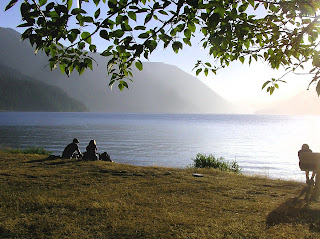 |
| Port Townsend |
Port Townsend is an old Victorian town at the northeast corner of the Olympic Peninsula - the main street down by the water, the next major street 100' up on the bluff.
 |
| At the Ft. Worden Beach |
 |
| Sailing Past the Fog |
We took the ferry across to Keystone on Whidbey Island, landing by a campground in sunshine, protected by the Fort Casey (another retired Coast Artillery fort) headlands. Up on the headlands the 100+ runners in a training program emerged from and disappeared into the fog. We went up the western coast, opposite the mouth of the Straits of Juan de Fuca and found Fort Ebey equally fogbound. So we turned to Coupeville, on the eastern, sunny side of the island, watching a regatta sailing in Penn Cove. We meandered southeast alongside Saratoga Passage through Langley toward the ferry at Clinton. When things got tacky on The Sea Ranch Board, I used to say it was time to move to Whidbey - the west side is more like Sea Ranch, but Langley's sun and wind protection are very appealing.
 |
| Approaching Mukilteo |
The ferry from Clinton to Mukilteo, on the mainland, is a short ride - 20 minutes. The drive from the Mukilteo ferry terminal to I-5 took us past the Boeing plant where 747s, 767s, 777s, and now 787s, are assembled. It used to be the largest manufacturing plant in the world, probably still is. Worth a tour, but we were there too late.
We finished the day, and Harriett's tour at one of Seattle's iconic restaurants, Ivar's Salmon House, looking down Lake Union at the Space Needle.
All in all, a very successful 10 days, notable for many comfortable joys, much humor, and a general sense of an experience well worth building upon. For Joan and me, there was the extra wonder of having seen all the major peaks in the Cascades from Mt. Shasta to Mt. Baker on one trip.















































